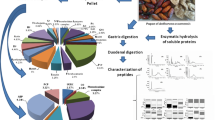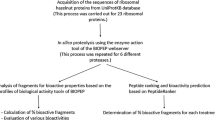Abstract
Arthrospira platensis proteins are considered as viable ingredients for functional foods with nutraceutical properties and health-promoting effects. In this study, we used five different proteases including pepsin, trypsin, alcalase, papain, and bromelain to hydrolyze A. platensis phycobiliprotein. LC–MS/MS (liquid chromatography-tandem mass spectrometry) was used to determine the composition of the hydrolysates with thousands of bioactive peptides. Based on peptide sequencing, a candidate list of 1,333 bioactive peptides was constructed for the first time for which bioinformatics tools were used to assess the properties of the bioactive peptides. The inhibitory activity of dipeptidyl peptidase IV (DPP-IV) and angiotensin-converting enzyme (ACE), as well as the antioxidant activity of five phycobiliprotein hydrolysates (PBPHs), were verified in vitro. The IC50 values of PBPH-pepsin, PBPH-trypsin, PBPH-alcalase, PBPH-papain, and PBPH-bromelain for DPP-IV inhibited activity were determined to be 4.059, 5.603, 5.257, 3.819, and 4.195 mg mL−1, respectively. All the above five PBPHs were also seen to significantly inhibit ACE activity (P < 0.0001) in the range of 0.1–1.0 mg mL−1. The activity of five PBPHs fraction was found for the 2-azino-bis (3-ethylbenzothiazoline6-sulfonic acid) diammonium salt (ABTS) assay (the highest was 1.37 mM Trolox equivalent of 30 mg mL−1 of PBPH-trypsin), 1,1diphenyl-2-picrylhydrazyl (DPPH) assay (the highest was 204.67 µM Trolox equivalent of 10 mg mL−1 of PBPH-pepsin), and Fe2+ chelating ability (the highest was 639.73 µM FeSO4 equivalent of 10 mg mL−1 of PBPH-trypsin). This study indicated that it was feasible to utilize A. platensis phycobiliprotein as a source of bioactive peptides which may be used as functional food and/or nutritional supplements for human health.








Similar content being viewed by others
Data availability
All data generated or analyzed during this study are included in this published article [and its supplementary information files].
References
Agrawal M, Bansal S, Chopra K (2021) Evaluation of the in vitro and in vivo antioxidant potentials of food grade phycocyanin. J Food Sci Technol 58:4382–4390
Aiello G, Lammi C, Boschin G, Zanoni C, Arnoldi A (2017) Exploration of potentially bioactive peptides generated from the enzymatic hydrolysis of hempseed proteins. J Ag Food Chem 65:10174–10184
Anekthanakul K, Senachak J, Hongsthong A, Charoonratana T, Ruengjitchatchawalya M (2019) Natural ACE inhibitory peptides discovery from Spirulina (Arthrospira platensis) strain C1. Peptides 118:170107
Becker EW (2007) Micro-algae as a source of protein. Biotechnol Adv 25:207–210
Christaki E, Bonos E, Florou-Paneri P (2015) Innovative microalgae pigments as functional ingredients in nutrition. In: Kim S-K (ed) Handbook of Marine Microalgae. Academic Press, Boston, pp 233–243
Cotabarren J, Rosso AM, Tellechea M, Garcia-Pardo J, Rivera JL, Obregon WD, Parisi MG (2019) Adding value to the chia (Salvia hispanica L.) expeller: production of bioactive peptides with antioxidant properties by enzymatic hydrolysis with Papain. Food Chem 274:848–856
Dufossé L (2018) Microbial pigments from bacteria, yeasts, fungi, and microalgae for the food and feed industries. In: Grumezescu AM, Holban AM (eds) Natural and artificial flavoring agents and food dyes. Academic Press, London, pp 113–132
Fan XD, Bai L, Zhu L, Yang L, Zhang XW (2014) Marine algae-derived bioactive peptides for human nutrition and health. J Ag Food Chem 62:9211–9222
Fu Y, Liu J, Hansen ET, Bredie WLP, Lametsch R (2018) Structural characteristics of low bitter and high umami protein hydrolysates prepared from bovine muscle and porcine plasma. Food Chem 257:163–171
Gupta S, Kapoor P, Chaudhary K, Gautam A, Kumar R, Raghava GP, Consortium OSDD (2013) In silico approach for predicting toxicity of peptides and proteins. PloS One 8 (9):e73957
Hanafi MA, Hashim SN, Chay SY, Ebrahimpour A, Zarei M, Muhammad K, Abdul-Hamid A, Saari N (2018) High angiotensin-I converting enzyme (ACE) inhibitory activity of Alcalase-digested green soybean (Glycine max) hydrolysates. Food Res Int 106:589–597
He YY, Li TT, Chen JX, She XX, Ren DF, Lu J (2018) Transport of ACE inhibitory peptides Ile-Gln-Pro and Val-Glu-Pro derived from Spirulina platensis across Caco-2 monolayers. J Food Sci 83:2586–2592
Heo SY, Ko SC, Kim CS, Oh GW, Ryu B, Qian ZJ, Kim G, Park WS, Choi IW, Phan TT, Heo SJ, Kang DH, Yi M, Jung WK (2017) A heptameric peptide purified from Spirulina sp. gastrointestinal hydrolysate inhibits angiotensin I-converting enzyme- and angiotensin II-induced vascular dysfunction in human endothelial cells. Int J Mol Med 39:1072–1082
Hou H, Li B, Zhao X, Zhang Z, Li P (2011) Optimization of enzymatic hydrolysis of Alaska pollock frame for preparing protein hydrolysates with low-bitterness. LWT - Food SciTechnol 44:421–428
Iwaniak A, Darewicz M, Mogut D, Minkiewicz P (2019) Elucidation of the role of in silico methodologies in approaches to studying bioactive peptides derived from foods. J Funct Foods 61:103486
Kęska P, Stadnik J (2017) Taste-active peptides and amino acids of pork meat as components of dry-cured meat products: An in-silico study. J Sensory Stud 32 (6):e12301
Kinariwala D, Panchal G, Sakure A, Hati S (2019) Exploring the potentiality of Lactobacillus cultures on the production of milk-derived bioactive peptides with antidiabetic activity. Int J Peptide Res Therapeut 26:1613–1627
Leticia M, Marta G, idel TF, (2018) New approaches based on comparative proteomics for the assessment of food quality. Curr Opin Food Sci 22:22–27
Li Y, Lammi C, Boschin G, Arnoldi A, Aiello G (2019) Recent advances in microalgae peptides: Cardiovascular health benefits and analysis. J Agric Food Chem 67:11825–11838
Li Y, Aiello G, Bollati C, Bartolomei M, Arnoldi A, Lammi C (2020) Phycobiliproteins from Arthrospira platensis (Spirulina): a new source of peptides with dipeptidyl peptidase-IV inhibitory activity. Nutrients 12:794
Lordan S, Ross RP, Stanton C (2011) Marine bioactives as functional food ingredients: potential to reduce the incidence of chronic diseases. Mar Drugs 9:1056–1100
Lupatini AL, Colla LM, Canan C, Colla E (2017) Potential application of microalga Spirulina platensis as a protein source. J Sci Food Agric 97:724–732
Martínez-Maqueda D, Miralles B, Recio I, Hernández-Ledesma B (2012) Antihypertensive peptides from food proteins: a review. Food Funct 3:350–361
Mi H, Huang X, Muruganujan A, Tang H, Mills C, Kang D, Thomas PD (2017) PANTHER version 11: expanded annotation data from Gene Ontology and Reactome pathways, and data analysis tool enhancements. Nucleic Acids Res 45:D183–D189
Minkiewicz P, Iwaniak A, Darewicz M (2019) BIOPEP-UWM database of bioactive peptides: current pportunities. Int J Mol Sci 20:5978
Montone CM, Capriotti AL, Cavaliere C, La Barbera G, Piovesana S, ZeneziniChiozzi R, Lagana A (2018a) Peptidomic strategy for purification and identification of potential ACE-inhibitory and antioxidant peptides in Tetradesmus obliquus microalgae. Anal Bioanal Chem 410:3573–3586
Montone CM, Capriotti AL, Cavaliere C, La Barbera G, Piovesana S, ZeneziniChiozzi R, Laganà A (2018b) Peptidomic strategy for purification and identification of potential ACE-inhibitory and antioxidant peptides in Tetradesmus obliquus microalgae. Anal Bioanal Chem 410:3573–3586
Nguyen HTH, Gathercole JL, Day L, Dalziel JE (2020) Differences in peptide generation following in vitro gastrointestinal digestion of yogurt and milk from cow, sheep and goat. Food Chem 317:126419
Nongonierma AB, Mooney C, Shields DC, FitzGerald RJ (2014) In silico approaches to predict the potential of milk protein-derived peptides as dipeptidyl peptidase IV (DPP-IV) inhibitors. Peptides 57:43–51
Ovando CA, de Carvalho JC, Pereira GVD, Jacques P, Soccol VT, Soccol CR (2018) Functional properties and health benefits of bioactive peptides derived from Spirulina: a review. Food Rev Int 34:34–51
Piskov S, Timchenko L, Grimm WD, Rzhepakovsky I, Avanesyan S, Sizonenko M, Kurchenko V (2020) Effects of various drying methods on some physico-chemical properties and the antioxidant profile and ACE inhibition activity of oyster mushrooms (Pleurotus ostreatus). Foods 9:160
Saha S, Raghava GPS (2006) AlgPred: prediction of allergenic proteins and mapping of IgE epitopes. Nucl Acids Res 34 (Web Server):W202-W209
Solymosi K, Mysliwa-Kurdziel B (2017) Phycobilins and phycobiliproteins used in food industry and medicine. Mini Rev Med Chem 17:1173–1193
Sonani RR, Rastogi RP, Patel R, Madamwar D (2016) Recent advances in production, purification and applications of phycobiliproteins. World J Biol Chem 7:100–109
Suetsuna K, Chen JR (2001) Identification of antihypertensive peptides from peptic digest of two microalgae, Chlorella vulgaris and Spirulina platensis. Mar Biotechnol (NY) 3:305–309
Toldra F, Gallego M, Reig M, Aristoy MC, Mora L (2020) Bioactive peptides generated in the processing of dry-cured ham. Food Chem 321:126689
Tu M, Liu H, Cheng S, Mao F, Chen H, Fan F, Lu W, Du M (2019) Identification and characterization of a novel casein anticoagulant peptide derived from in vivo digestion. Food Funct 10:2552–2559
Velliquette RA, Fast DJ, Maly ER, Alashi AM, Aluko RE (2020) Enzymatically derived sunflower protein hydrolysate and peptides inhibit NFκB and promote monocyte differentiation to a dendritic cell phenotype. Food Chem 319:126563
Vo TS, Kim YS, Ngo DH, Le PU, Kim SY, Kim SK (2018) Spirulina maxima peptides suppress mast cell degranulation via inactivating Akt and MAPKs phosphorylation in RBL-2H3 cells. Int J Biol Macromol 118:2224–2229
Wang K, Luo Q, Hong H, Liu H, Luo Y (2021a) Novel antioxidant and ACE inhibitory peptide identified from Arthrospira platensis protein and stability against thermal/pH treatments and simulated gastrointestinal digestion. Food Res Int 139:109908
Wang Y-Y, Wang C-Y, Wang S-T, Li Y-Q, Mo H-Z, He J-X (2021b) Physicochemical properties and antioxidant activities of tree peony (Paeonia suffruticosa Andr.) seed protein hydrolysates obtained with different proteases. Food Chem 345:128765
Xiao C, Zhao M, Zhou F, Gallego M, Gao J, Toldrá F, Mora L (2020) Isolation and identification of alcohol dehydrogenase stabilizing peptides from Alcalase digested chicken breast hydrolysates. J Funct Foods 64:103617
Xie J, Chen X, Wu J, Zhang Y, Zhou Y, Zhang L, Tang YJ, Wei D (2018) Antihypertensive effects, molecular docking study, and isothermal titration calorimetry assay of angiotensin I-converting enzyme inhibitory peptides from Chlorella vulgaris. J Agric Food Chem 66:1359–1368
Zeng QH, Fan XD, Zheng QP, Wang JJ, Zhang XW (2018) Anti-oxidant, hemolysis inhibition, and collagen-stimulating activities of a new hexapeptide derived from Arthrospira (Spirulina) platensis. J Appl Phycol 30:1655–1665
Zeng Q, Jiang J, Wang J, Zhou Q, Zhang X (2019) N-terminal acetylation and C-terminal amidation of Spirulina platensis-derived hexapeptide: anti-photoaging activity and proteomic analysis. Mar Drugs 17:520
Zeng QH, Wang JJ, Zhang YH, Song YQ, Liang JL, Zhang XW (2020) Recovery and identification bio-active peptides from protein isolate of Spirulina platensis and their in vitro effectiveness against oxidative stress-induced erythrocyte hemolysis. J Sci Food Agric 100:3776–3782
Zheng J, Wang J, Pan H, Wu H, Ren D, Lu J (2017) Effects of IQP, VEP and Spirulina platensis hydrolysates on the local kidney renin angiotensin system in spontaneously hypertensive rats. Mol Med Rep 16:8485–8492
Acknowledgements
All the authors are thankful to the financial support by the Research Start-Up Funds from Hainan University in China (KYQD_ZR2017212).
Author information
Authors and Affiliations
Corresponding author
Additional information
Publisher's note
Springer Nature remains neutral with regard to jurisdictional claims in published maps and institutional affiliations.
Supplementary Information
Below is the link to the electronic supplementary material.
10811_2022_2732_MOESM4_ESM.xlsx
Supplementary file4 Table S3 Biological activity confirmed by the BIOPEP-UWM database of all identified peptides (XLSX 58 KB)
Rights and permissions
About this article
Cite this article
Liu, J., Bai, X. & Fu, P. In silico and in vitro assessment of bioactive peptides from Arthrospira platensis phycobiliproteins for DPP-IV inhibitory activity, ACE inhibitory activity, and antioxidant activity. J Appl Phycol 34, 1497–1511 (2022). https://doi.org/10.1007/s10811-022-02732-z
Received:
Revised:
Accepted:
Published:
Issue Date:
DOI: https://doi.org/10.1007/s10811-022-02732-z




